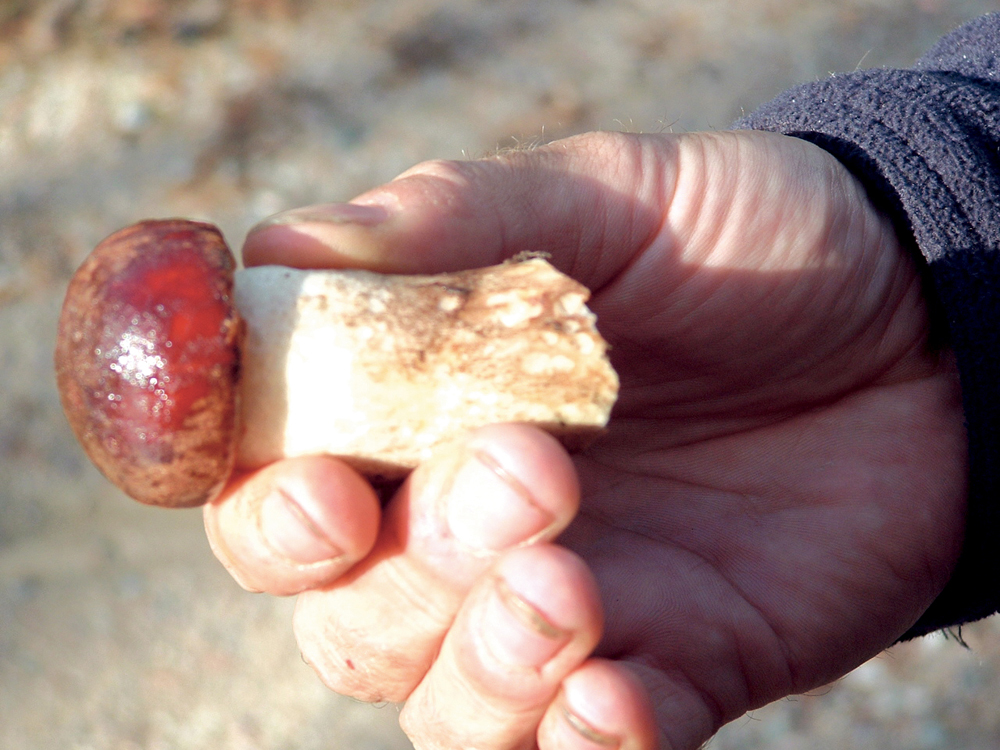
The Cree Nation is always looking for a way to bolster its economy and protect traditional territory at the same time. With a new pilot project currently in the development phase that would see trappers harvesting and selling mushrooms down south and abroad, it could soon be meshing both worlds together in perfect harmony.
Researchers from the Universities of Toronto and Laval with PhD’s in Mycology visited Chisasibi traplines in September 2007 and found approximately 300 different species of mushrooms. Although most of them have no commercial value, at least a few, including the coveted Matsutake mushroom, are worth a lot of money.
Although Matsutake mushrooms are found in western Canada and parts of the U.S., Gilbert Hamel, a consultant for the pilot project, said that their taste is closer to those found in Japan.
“There are four or five edible mushrooms in the area,” said Hamel, who works with the Chisasibi Business Service Centre (CBSC).
“The Matsutake alone could represent millions of dollars a season. When you have them shipped fresh, they are worth $250 a kilogram. When they’re dried, they’re worth $l50-$200 a kilogram. We have a contact that needs five tons every year. It’s a lot of money.
Eric House, CBSC General Manager, said that although it is possible that these mushrooms were used traditionally, that knowledge has not been passed down.
“We don’t want it to be commercial first,” said Hamel. “We want to gain the knowledge about the mushrooms, do science experiments with school groups and various other things. We are trying to get people interested in these mushrooms and non-timber products.”
He also sees it as a way to protect traplines from unwanted incursions by non-Natives and over-zealous forestry companies.
Hamel and House are in the midst of setting up an as-yet-unnamed co-op with the Cox, Chiskamish and Nineoclock families as founding members. After that, he is hoping a large number of James Bay’s 300 family traplines join in.
Tallymen would not be obligated to harvest their mushrooms by joining the co-op but they could stay for an undetermined amount of time in a state of “inventory” which would protect their land nonetheless.
Those who wish to partake in the project however, would have the option of “transferring” the mushrooms themselves, after learning how to do so from experts, or allowing others to do it for them and splitting the profits when they are sold.
The pilot project is being developed after the Chisasibi contingent was shut out of a similar Municipalite de la Baie James (MBJ) project, called Rural Laboratories. In it, researchers are given $100,000 a year for six years to study the different types of wild fungi that grow around trees.
Mushrooms are the fruit of a living organism called mycelium. Mycelium is a fungus which attaches itself to a tree’s roots where they become inseparable. The mycelium provides the tree with water and nutrients and the tree, in turn, provides food for the mycelium.
Hamel talked about the dangers of non-Native researchers unfamiliar with Cree traplines surveying the mushrooms in the summer and fall.
“They go on the land and they don’t know where to walk or step,” said Hamel. “There are animal traps and in many cases they do a lot of damage to various aspects of plant and animal life on the land. We are trying to figure out a
way to harvest the land for sustainable development but to protect the
land as well.”
Hamel has spoken to Gerald Legal, owner of les Gourmets Sauvage, a company that specializes in harvesting mushrooms and other wild products.
“He understands that the future of harvesting non-timber products is with the Cree,” said Hamel. “He realizes without the Cree he won’t be able to develop his business.”
Hamel and Eric House of CBSC are trying a last ditch effort to get into the Rural Laboratories project which has been closed to the Crees as of December.
“That project should be open to everyone in the MBJ, not just the non-Natives,” said Hamel.
The harvesting also enables those who are not out moose or goose hunting to collect the mushrooms and to make extra money, said Hamel.
“They will have an activity on their land that will help them keep their traditional way of life while bringing them revenues during the key months of August and September.”
Hamel sees a niche tourism sector that could allow Japanese tourists the chance to harvest their own mushrooms, with the blessing of the local tallyman, and re-sell them in their native country. In Japan, the mushrooms are worth 11 times their marketable value in Canada.
Training will be given to tallymen during the summer and fall on how to harvest, treat and dry the mushrooms. They are also looking at harvesting berries.
“Eventually it will touch every product made from the land,” said Hamel.“ For example, a tamarack tree used to make snowshoes and moose hide are other products that come from the land.”
A courier deal with empty KEPA trucks heading south could reduce shipping costs.
Although the project is starting off slow by focusing on Chisasibi traplines first, a meeting with the Cree Trappers Association to inform every tallyman through information packages is in the works.
“The potential of non-timbers products in Eeyou Istchee is incredible,” said Hamel. “You can make soup with the dried mushrooms or trail mix with the dried berries and that is only a small part of each trapline’s potential.”

